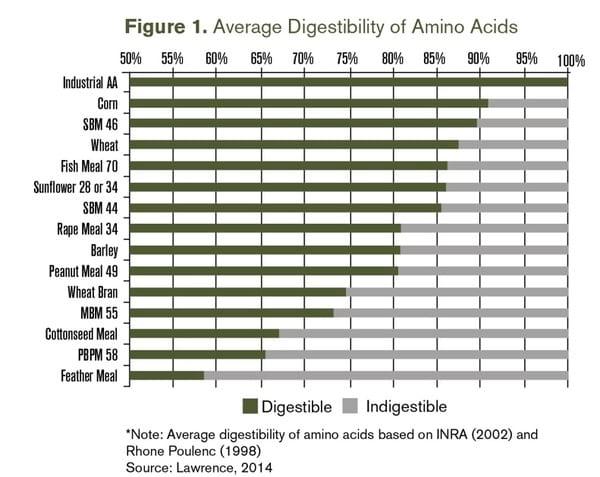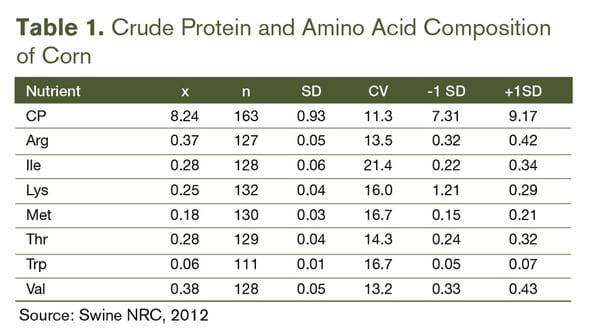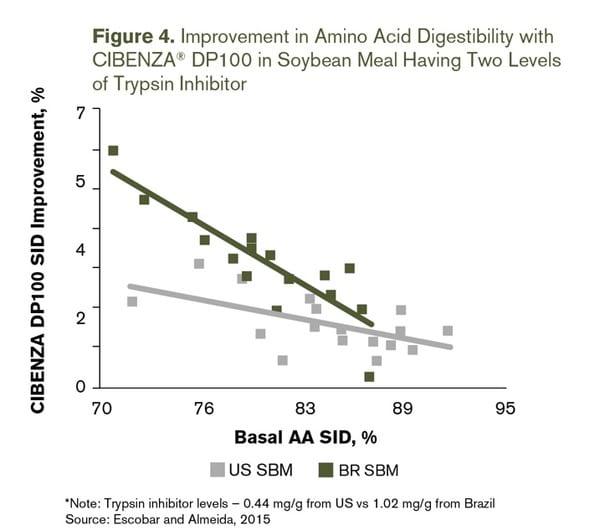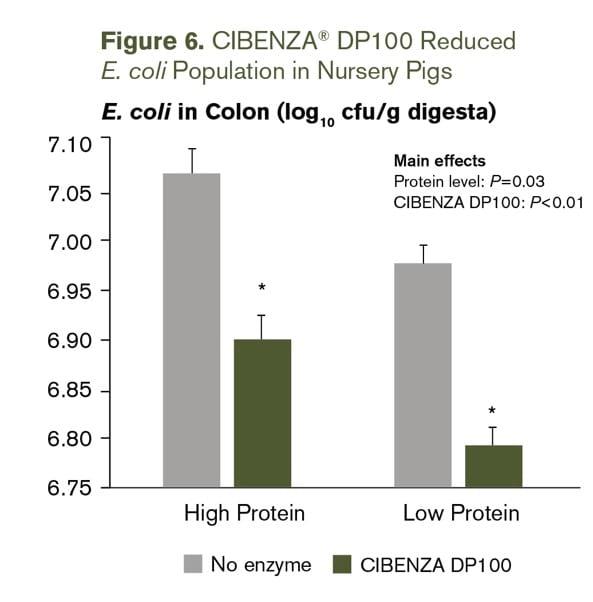Improving precision feeding with protease
Published: October 25, 2017
By: Howard Simmins - InSci Associates Ltd., Ferdinando Almeida, Ph.D. – Research Scientist, Swine Nutrition, Novus International, Inc.
Constraints to achieving precision feeding
Today, feed can be formulated to an accuracy of many decimal places. This is vital for effective least cost formulation, as feed accounts for over 70 percent of animal production costs. Many factors can contribute to reducing the value of that accuracy, such as growing conditions, animal health, management and the nutritional value of feedstuffs used. Feed, therefore, is formulated to minimize nutritional risk, which typically results in over-formulation and increased feed costs. This is not the precision we seek.
Over-formulation can raise other risks, such as health, environmental impact and performance effects. Providing accurate information on the availability of amino acids in feedstuffs to optimize performance and lower the risks has been exercised in the feed industry for the past half century. Part of the solution has been the increase in use of synthetic amino acids. However, it is impractical to supplement all amino acids to achieve a balanced diet. Similarly, the industry has measured the standardized ileal digestible (SID) amino acids of most feedstuffs, but again, it is unrealistic to assess the SID for every batch of feed in all parts of the world. The use of CIBENZA® DP100 protease feed supplement however, has emerged as a key component in reducing variation in amino acid digestibility in feedstuffs, moving many producers closer to the desired target of precision feeding.
Variation in amino acid levels in feedstuffs
Each of the 20 primary essential and non-essential amino acids are required in sufficient quantities for the animal to deposit protein efficiently. In practice, balancing feeds nutritionally is challenging, especially when the objective is to provide a cost-effective solution. Using lower cost feed may introduce variances in ingredients (Figure 1). While the nutrient composition of ingredients varies naturally, the expectation is that the feed achieves the nutritional requirements of the animal for at least 80 percent of the times it is produced. To achieve this target, measuring the variation in digestible amino acids for each raw material is important. The greater the level of undigested amino acids, the more variability a particular feedstuff will exhibit.
Today, feed can be formulated to an accuracy of many decimal places. This is vital for effective least cost formulation, as feed accounts for over 70 percent of animal production costs. Many factors can contribute to reducing the value of that accuracy, such as growing conditions, animal health, management and the nutritional value of feedstuffs used. Feed, therefore, is formulated to minimize nutritional risk, which typically results in over-formulation and increased feed costs. This is not the precision we seek.
Over-formulation can raise other risks, such as health, environmental impact and performance effects. Providing accurate information on the availability of amino acids in feedstuffs to optimize performance and lower the risks has been exercised in the feed industry for the past half century. Part of the solution has been the increase in use of synthetic amino acids. However, it is impractical to supplement all amino acids to achieve a balanced diet. Similarly, the industry has measured the standardized ileal digestible (SID) amino acids of most feedstuffs, but again, it is unrealistic to assess the SID for every batch of feed in all parts of the world. The use of CIBENZA® DP100 protease feed supplement however, has emerged as a key component in reducing variation in amino acid digestibility in feedstuffs, moving many producers closer to the desired target of precision feeding.
Variation in amino acid levels in feedstuffs
Each of the 20 primary essential and non-essential amino acids are required in sufficient quantities for the animal to deposit protein efficiently. In practice, balancing feeds nutritionally is challenging, especially when the objective is to provide a cost-effective solution. Using lower cost feed may introduce variances in ingredients (Figure 1). While the nutrient composition of ingredients varies naturally, the expectation is that the feed achieves the nutritional requirements of the animal for at least 80 percent of the times it is produced. To achieve this target, measuring the variation in digestible amino acids for each raw material is important. The greater the level of undigested amino acids, the more variability a particular feedstuff will exhibit.

A further challenge is that databases may show variability of amino acids as +/- one standard deviation (SD). One SD accounts for only 68 percent of the variation of the samples of a feedstuff. An example is the range of amino acid variability in corn samples (Table 1). Lysine is shown to have a potential concentration between of 0.21 and 0.24 percent in 68 percent of the samples (+/- one SD). Another way of presenting the data would be that lysine has concentrations below 0.21 and above 0.29 percent in 32 percent of the samples, the actual levels being unknown. This is an unacceptable degree of uncertainty for precision feeding. Therefore, in practice, both energy and amino acids will be in excess, if feeds are formulated to ensure the majority of animals are being provided with adequate nutrients. Consequently, feed costs and nitrogen excretion will be higher than necessary, heightening the risk of poorer health and less efficient performance.

Improving amino acid digestibility with protease
The main source of protein used in monogastric feed is soybean meal, which represents 55 percent of the global production of all oilseeds. Other vegetable sources include canola meal, DDGS, soybean hulls and peas, as well as animal sources such as meat and bone meal and fish meal.
Soybean meal may have up to 49 percent protein, which is highly digestible and reasonably well balanced in amino acids for non-ruminants, but quality varies between regions. Conversely, soybeans contain anti-nutritional factors (ANFs), which reduce amino acid availability and depress growth performance. The presence of high levels of dietary trypsin inhibitors from soybeans and other grain legumes can cause reductions of up to 50 percent in amino acid digestibility in rats and pigs (Gilani et al, 2005).
Protease reduces the proportion of indigestible amino acids in feedstuffs, resulting in a corresponding increase in digestible amino acids. Generally, the more indigestible the level of amino acid present, the greater the increase in digestibility when protease is added. With the addition of a high quality protease, SID% improvements can be realized in feedstuffs.
Soybean meal tested by Novus International, which had a digestibility of around 90 percent, exhibited an overall SID improvement of around 3 percent. Corn, which had a digestibility of around 75 percent, had an overall SID of around 4.5 percent, whereas meat and bone meal, started at under 60 percent SID, showed a 6 percent improvement (Figures 2 and 3). These figures will change with a specific batch of feedstuff, but confirm that the effects of protease increase when more indigestible protein is present.


Additionally, protease reduces the effects of ANFs found in proteins, thus helping to improve the digestibility of amino acids. Research conducted to explore the combination of trypsin inhibitor and SID% has shown the greater the level of soy trypsin inhibitor substrate on which the protease has to operate, the greater the SID% improvement (Figure 4).

However, for feed formulators, the value is not only the increase in digestibility, but also the reduction in variation in amino acids (Figure 5). Soybean meal is highly digestible, but showed notable responses to the addition of CIBENZA DP100. When protease was added, the risk from having low digestible individual amino acid values was reduced. Accessing such data for individual amino acids provides the opportunity to include lower quality ingredients at higher levels, as well as reduce the nutrient overage in the feed formulation without changing the risk level. This functionality is unique to protease, which is why it has been called “the next amino acid.”

Further benefits of protease
The potential to feed monogastric animals closer to their optimum amino acid requirements, with the addition of protease in diets, has multiple benefits. Risk of E. coli growth and resulting post-weaning diarrhea in swine is lower through the reduction of the level of undigested protein in the hind gut and reduced trypsin inhibitors (Figure 6).

Another benefit from lower protein diets through protease use is the reduction of ammonia levels in animal buildings, which could mitigate the risk of respiratory diseases. Lower protein diets also reduce nitrogen excretion and, therefore, the total excreta produced.
The improved precision feeding possible with the inclusion of CIBENZA DP100 not only reduces feed cost, but also provides the opportunity for better health, performance and reduced waste. These outcomes are achieved through a deeper understanding of the variation in levels of nutrients and ANFs in feedstuffs and how they could be reduced using protease. Overage in feed formulation can be controlled while managing risks. This is an important step towards cost-effective precision feeding.
The improved precision feeding possible with the inclusion of CIBENZA DP100 not only reduces feed cost, but also provides the opportunity for better health, performance and reduced waste. These outcomes are achieved through a deeper understanding of the variation in levels of nutrients and ANFs in feedstuffs and how they could be reduced using protease. Overage in feed formulation can be controlled while managing risks. This is an important step towards cost-effective precision feeding.
References available upon request
Related topics
Authors:
Join to be able to comment.
Once you join Engormix, you will be able to participate in all content and forums.
* Required information
Would you like to discuss another topic? Create a new post to engage with experts in the community.
Create a post






.jpg&w=3840&q=75)